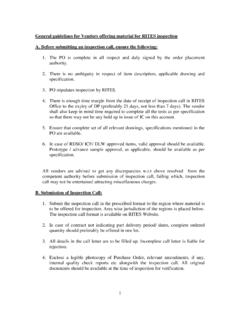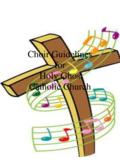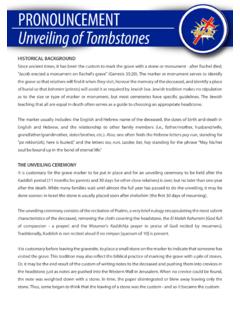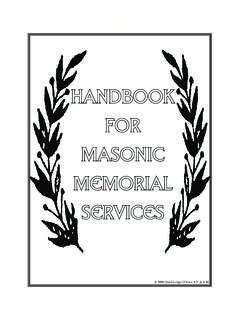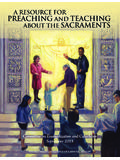Transcription of Guidelines for Funerals and Burials in the Catholic …
1 May 2, 2012 Guidelines for Funerals and Burials in the Catholic Church Foreword This booklet provides general information to the Catholic community and to those who provide services when death occurs. Death in the Christian Context Catholic belief in death as the entrance into eternity, hope in the resurrection, recognition of the value of prayer for the deceased, reverence for the body which remains and the sense of mystery and sacredness which surround the end of earthly life are all reflected in the Church s care for the deceased and the family and community that survives them. Private and liturgical prayer, meditation, reflection and the liturgical rites connected with the funeral and committal unite us to the Lord s paschal mystery and our hope of eternal union with almighty God.
2 The events which surround death call for a community response. Although the immediate family bears a heavy burden of sorrow, relatives, friends and parishioners provide prayerful support. Church Law The funeral of any deceased member of the faithful should normally be celebrated in the church of that person's proper parish (canon 1177, 1). However, any member of the faithful, or those in charge of the deceased person's funeral , may choose another church; this requires the consent of whoever is in charge of that church and a notification to the proper parish priest of the deceased (canon 1177, 2). When death has occurred outside the person's proper parish, and the body is not returned there, and another church has not been chosen, the funeral rites are to be celebrated in the church of the parish where the death occurred, unless another church has been designated by particular law (canon 1177, 3).
3 Vigil Service In her funeral rites, the Church commends the dead to God and offers Christian hope to those who mourn. For this reason, it is customary to have a gathering of the family and friends of the deceased between death and burial . The wake or prayer service may take the form of one of the vigil services contained in the funeral ritual or a similar service, such as the prayer of the Rosary. It usually happens on the day preceding the funeral . Preferably, it is held in the church but may take place in the funeral home or the home of the deceased. 1 May 2, 2012 funeral Mass The Mass, the memorial of Christ's death and resurrection, is the principal celebration of the Christian funeral . While following the directives of the Church's ritual in planning the liturgical celebration, the choice of music, colour of vestments, biblical readings, and homily should reflect the family s wishes, while emphasizing as well the community aspect of faith which remains unbroken in death.
4 The funeral Mass is customarily celebrated on the day of burial . However, for pastoral reasons the Mass may be celebrated at some other time before the burial , such as the previous evening. In any event, there should be only one funeral Mass. Since the proper setting for Mass is a sacred place. Mass is not to be celebrated in a funeral home or similar facility. The body of the deceased should be present in church for the funeral Mass or Mass of Christian burial . The term "Mass of the Resurrection" is incorrect for the funeral Mass. Keeping in mind that liturgical roles are to be fulfilled only by Catholics, members of the family who are Catholic are encouraged to assume the role of readers and assist in the offertory procession. They may receive Holy Communion under both species.
5 In accordance with the Church's teaching, Holy Communion is not given to non-Catholics, but they may serve as pallbearers. The casket remains closed during the funeral and should be covered with a white pall in remembrance of the baptismal garment. In addition to its liturgical significance, the pall serves a very practical purpose: it avoids ostentation, prevents possible embarrassment of the poor and emphasizes Christians equality before God. Apart from distinctions based on sacred orders and the honour due to civic dignitaries, no special honours are paid to any private person or classes of persons, whether in the ceremony or by external display. Eulogy The Order of Christian Funerals states that a brief homily based on the readings is always given after the Gospel there is never to be a eulogy.
6 The homily relates Christian death to the paschal mystery of our Lord's death and resurrection. Attentive to the grief of those present, the homily properly includes an expression of praise and gratitude to God for the gift of a Christian life and such virtues or strengths apparent in the deceased's life. A brief eulogy may take place in this order of preference: at the conclusion of the vigil service; at a reception following the funeral Mass; before the funeral Mass begins; following the prayers of committal at the cemetery; prior to the final commendation and farewell. The speaker should have a written text approved beforehand by the officiating priest. There should be only one eulogist, and the person must be of upright reputation. 2 May 2, 2012 funeral Liturgy outside Mass The funeral liturgy outside of Mass is ordinarily celebrated in the parish church, but may be celebrated in the home of the deceased, a funeral home or in a cemetery chapel.
7 Generally speaking, Mass may not be offered as part of the funeral rites for those not entitled to a Catholic funeral according to Church law. Following careful consideration of the deceased's relationship with the Church, the needs and wishes of the bereaved family, and the attitude of the community, the pastor may offer a funeral liturgy outside Mass. This rite may also be appropriate for a deceased Catholic when no members of the family practice the faith. The body of the deceased should be present for the service. Even though Mass may not be celebrated as part of the funeral rite in these situations, it may be offered at another time for the repose of the soul of the deceased and for the spiritual well-being of the relatives and friends. Ecumenical Considerations When requested by the Catholic relatives of a deceased baptized non- Catholic , a priest may conduct a prayer service for the non- Catholic in a funeral home.
8 In particular circumstances where the deceased non- Catholic was well disposed to the Church, and the family requests Mass, it may be celebrated with the body present in church. Place of burial Whenever possible, those who were part of the Catholic community are buried in a Catholic cemetery. As well as being a sacred place, it recalls the community of all the faithful, living and deceased. When a Catholic is to be interred in other than a Catholic cemetery, the priest will bless the individual space and then follow the usual ritual. Rite of Committal This service at the cemetery is the last farewell, in which the Christian community honours one of its members before the body is buried or entombed. With priest and mourners accompanying the body to the cemetery, the rite is celebrated at the grave or tomb or in a cemetery committal chapel.
9 When a non- Catholic is to be buried in a Catholic cemetery, the minister of the deceased s faith community may conduct the burial service according to the minister's own ritual. If the family of the non- Catholic deceased person requests a Catholic priest to conduct the burial service, the priest will celebrate a rite which is appropriate. For those involved in civic organizations and those with additional affiliations, patriotic or fraternal services may also be conducted following the burial rite. 3 May 2, 2012 Cremation Through the centuries, the Church has followed the practice of burial or entombment after the manner of Christ's own burial . This expresses respect for the human body as a member of Christ and faith in the resurrection of the body. "The Church earnestly recommends that the pious custom of burial be retained; but it does not forbid cremation, unless this is chosen for reasons which are contrary to Christian teaching" (canon 1176, 3).
10 It is the priest s responsibility to verify the proper motivation and to determine that those arranging for the funeral have made satisfactory provision for the cremated remains, preferably in a Catholic cemetery. When these required conditions are met, the various elements of the Catholic funeral rite are conducted in the usual way. The body of the deceased should be present for the funeral Mass. The respect that the Church has for the bodies of the deceased should also be evident in the way cremated remains are treated before burial . Although ordinarily the body is present for the funeral , there may be occasions when, with the approval of the bishop, it is permitted to celebrate the funeral liturgy, including the Eucharist, in the presence of the ashes of the deceased.


